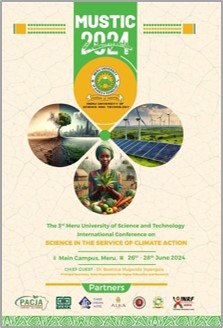Socio-Economic Determinants of Latrine Use in Imenti North Sub County, Meru County, Kenya
Keywords:
Sanitation, Latrine Use, Socio-Economic Factors, Public Health, Rural SanitationAbstract
Sanitary latrine access is crucial for public health and sustainable development. This access significantly reduces morbidity and mortality from diseases like diarrhea. Despite global efforts, 3.6 billion people lacked access to safely managed sanitation services in 2020, with sub-Saharan Africa and rural areas disproportionately affected. In Kenya, only 33% of the population has improved sanitation, with significant disparities across the regions. The study was conducted in Imenti North Sub County, Meru County, Kenya, with a population of 548,161 and 57,668 households. The target sample was 396 households, calculated using the Yamane formula, and data was collected through questionnaires, observation checklists, and interviews. A cross-sectional descriptive study design incorporating both quantitative and qualitative methods was employed. Purposive and cluster sampling techniques were used to obtain appropriate sample size. From each cluster, simple random sampling technique was utilized to choose the respondents. Data analysis was conducted using SPSS Version 26 to generate descriptive and inferential statistics. The study established that 72% of household heads were male. Most respondents had primary education (41%), and over half were not employed, indicating economic instability. On sanitation practices, 68% of households had 4-8 occupants, affecting latrine use and hygiene. The main obstacles to latrine ownership were lack of land (29.5%) and financial constraints (22.2%). In conclusion Socio-economic factors, including education, income, and household size, significantly impact latrine use in Imenti North. Addressing these issues through targeted health education, affordable sanitation solutions, and community engagement is crucial for improving sanitation practices.
Downloads
Published
How to Cite
Issue
Section
License
Copyright (c) 2025 Meru Universty of Science and Technology International Conference (MUSTIC)

This work is licensed under a Creative Commons Attribution-ShareAlike 4.0 International License.

